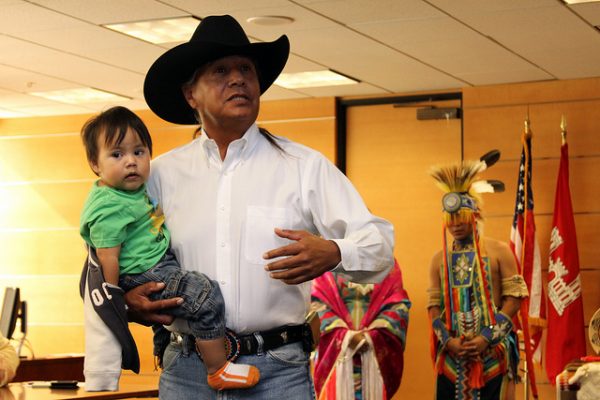
After years of debate, the Indian Child Welfare Act (ICWA) — which sets minimum requirements for caseworkers handling state child custody proceedings involving Native children — was recently ruled unconstitutional by a Texas federal judge. The judge argued that ICWA violates constitutional rights to Equal Protection because it “elevates a child’s race over their best interest” — despite the fact that Native children are actually citizens of federally recognized tribes. Social science research helps us understand the historical context necessitating ICWA’s creation, with respect to the problematic history of child removal from Native communities as shaped by racialized, gendered, and cultural ideas.
The ICWA was enacted in 1978, a time when Native children were being removed from their homes and placed in foster care at staggering numbers under the guise of protecting children. At that time, 25-35% of Native children were removed from their homes by state child welfare or by private adoption companies. And the majority (about 85%) of these children were placed outside of their families and communities, even when relatives were willing to take them. Today, despite the minimal protections offered by the ICWA, Minnesota places more Native children in foster care than any other state, making up 20% of children in the system.
- Lila J. George. 1997. “Why the Need for the Indian Child Welfare Act?” Journal of Multicultural Social Work 5(3): 165-175.
- Margaret D. Jacobs. 2014. A Generation Removed: The Fostering and Adoption of Indigenous Children in the Postwar World. University of Nebraska Press.
The ICWA’s creation and implementation has not only been a response to child-removal through adoption, however. Even earlier, Native children were sent to government or Christian-run boarding schools where teachers forced children to abandon their distinct tribal cultures — they cut Native children’s hair, did not allow them to speak their native languages or participate in cultural practices, and enforced strict discipline through corporal punishment. The boarding school era prevented generations of Native people from learning (and passing on) parenting tools. This separation of families, along with the disruption to Native cultural and spiritual practices, has been linked to symptoms similar to post-traumatic stress disorder, increased exposure to physical violence, and substance abuse in Native communities.
- Brenda J. Child. Boarding School Seasons: American Indian Families, 1900-1940. University of Nebraska Press.
- Catherine Burnette. 2015. “Historical Oppression and Intimate Partner Violence Experienced by Indigenous Women in the United States: Understanding Connections.” Social Service Review 89(3): 531-563.
The removal of Native children is also couched in deep-set racialized, gendered, and cultural notions of family, specifically the white middle class ideal of the nuclear family, characterized by two married parents and children. Conversely, non-Native supporters of these adoption practices often relied on stereotypes of Native women as sexualized, unmarried, and thus unfit, which pathologized Native families as neglectful. They have also argued that each child’s best interests should be considered on an individual basis, rathering than acknowledging what tribes see as the importance of culture and identity, tribal rights, and belonging. In other words, supporters of Native adoption saw “disadvantaged” Native children that needed to be “rescued” by individual acts of goodwill (from white, middle class Americans).
- Margaret D. Jacobs. 2013. “Remembering the ‘Forgotten Child’: The American Indian Child Welfare Crisis.” American Indian Quarterly
- Dwanna Robertson. 2015. “Invisibility in the Color-Blind Era: Examining Legitimized Racism Against Indigenous Peoples.” American Indian Quarterly 39(2): 113-153.
- Kathryn A. Sweeney and Rachel L. Pollack. 2017. “Colorblind Individualism, Color Consciousness, and the Indian Child Welfare Act: Representations of Adoptee Best Interest in Newspaper Coverage of the Baby Veronica Case.” The Sociological Quarterly 58(4): 701-720.
So what will legal reconsideration of the Indian Child Welfare Act bring? Many tribes fear that the Texas ruling sets a dangerous precedent that could dismantle the federal laws put in place to correct historical injustices like the boarding school system. Other tribal leaders see the ruling as an attempt to destroy their right to political and cultural survival through their children, while simultaneously compromising efforts to heal from the wrongdoings inflicted upon tribal communities. In the context of the current political division over the treatment of immigrant children separated from their parents at the U.S. border, such concerns warrant serious attention.

Comments